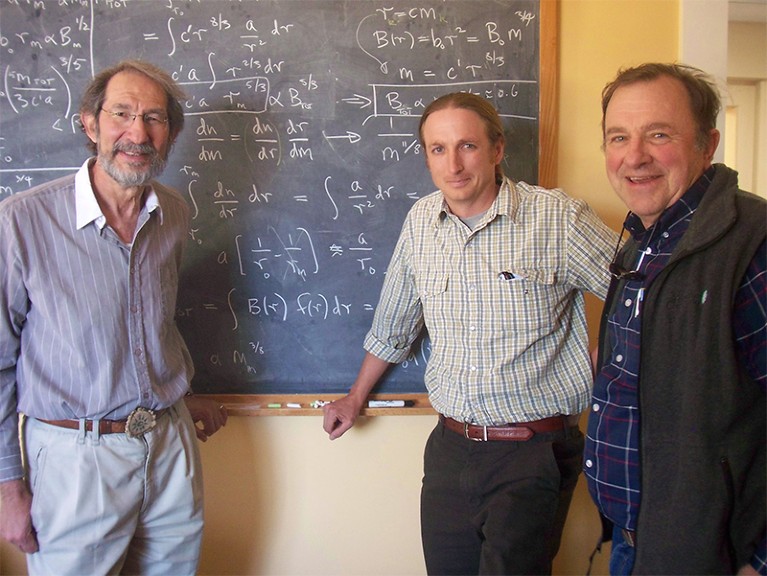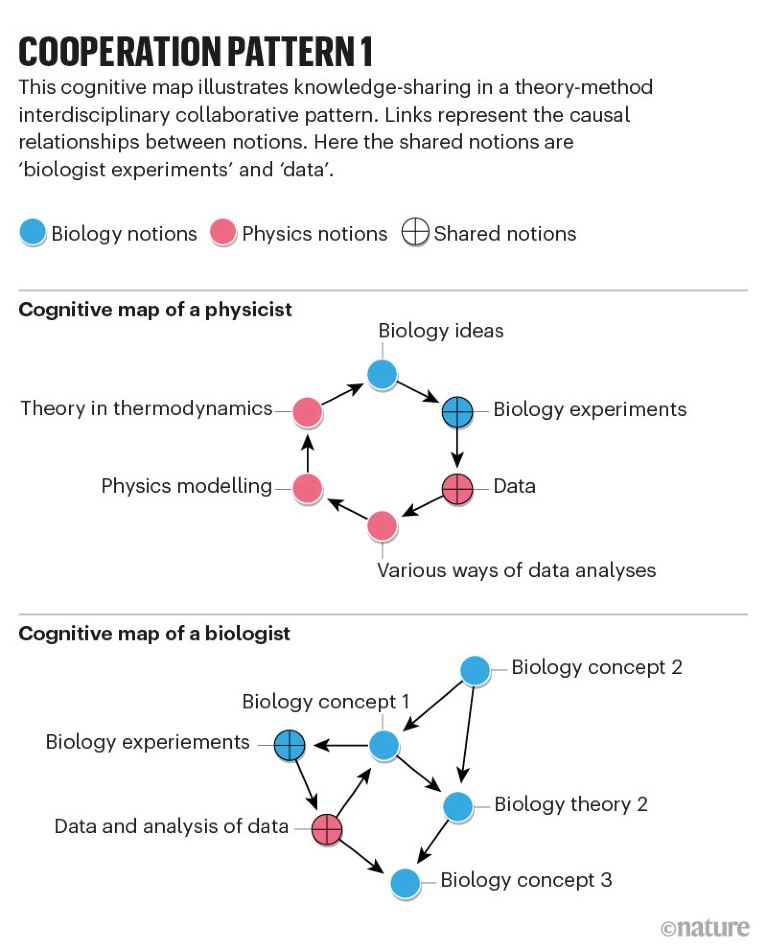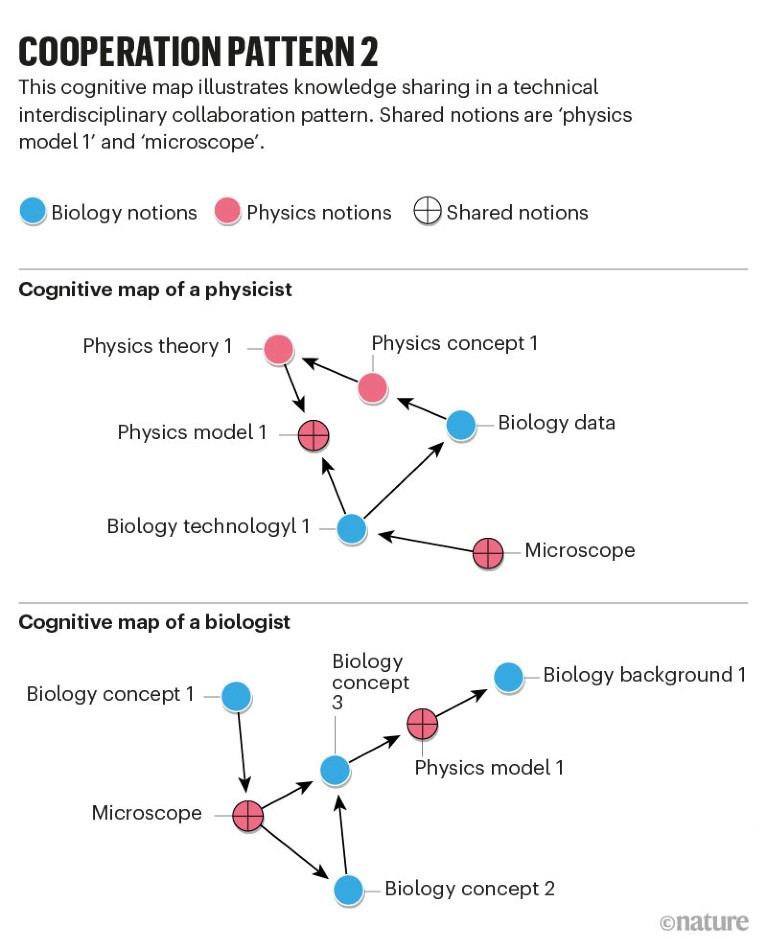
Cognitive mapping illuminates methods for effective research collaboration.Credit: Olivier Beauchesne & Scimago Lab, data by Scopus/SPL
Much of scientific collaboration involves transactional interactions, in which researchers simply exchange technologies or techniques, with no real sharing of knowledge. For example, Geoffrey Harris, a physiologist who established the field of neuroendocrinology, employed a chemist to isolate a brain hormone in the late 1970s. Harris was not interested in how the chemist-for-hire worked, as long as it resulted in pure forms of the hormone1.
Other types of collaboration are more immersive. In 1997, for example, two ecologists at the University of New Mexico, James Brown and Brian Enquist, published a paper with theoretical physicist, Geoffrey West, at the Los Alamos National Laboratory on the metabolic scaling theory, a formula explaining the relationship between an organism’s metabolic rate and its mass and temperature (G. West et al. Science 276, 122–126, 1997). The theory was the result of weekly discussions between the ecologists and the physicist.

Geoffrey West, Brian Enquist and James Brown, pictured here in about 2008, collaborated on a formula for the relationship between metabolic rate, mass and temperature.Credit: Laura Ware/Santa Fe Institute
As scientists increasingly reach across disciplinary divides, the success of collaborations can hinge on how they choose to exchange knowledge. Our analysis suggests that their approach should be based on an understanding of the way that different teams initiate research and the subjects they choose to cover. We offer some practical tips for researchers to improve the effectiveness of their interdisciplinary collaborations.
Patterns of integration
Interdisciplinary collaborative projects are an exercise in sharing, from funding to human resources, technologies, and knowledge.
Nature Index 2019 Collaboration and big science
We conducted intensive fieldwork of three such projects at a German university, involving interviews with 37 researchers, participant observation and cognitive mapping. Our study identified two distinct patterns of knowledge integration2.
The first, which we refer to as the theory-method interdisciplinary collaborative pattern, involves one party providing a theoretical understanding, and the other offering methods for collecting and analysing the data.
Cognitive maps illustrating this pattern are made up of nodes that represent scientific notions, and links that represent logical relationships between these notions. Participants share structural elements of their cognitive maps, meaning they have overlapping scientific notions as well as causal links between these notions. This sharing of notions and causal links is the minimum requirement for a theory-method form of collaboration.

The second pattern, namely the technical interdisciplinary collaborative pattern, occurs when interdisciplinary collaborations are established to merely share the participants’ respective technological approaches or assets, such as a particular algorithm or a loaned microscope. In this pattern, a single shared scientific concept may be the only interface between two disciplines necessary to establish an interdisciplinary collaboration project.

A full understanding of these two distinct patterns of knowledge sharing can enhance their efficiency, productivity and funding requirements. For this, we need to also consider two different types of research procedures and whether research topics are the same or different.
The research procedure refers to whether the research was theory initiated or data initiated, and the sequence of tasks performed during the process.
The two collaborative patterns resolve into four scenarios of interdisciplinary collaboration2 (see ‘Four scenarios’). Researchers who share the same research topic and procedure and working within the same discipline do not need to worry about the complexities of interdisciplinary collaboration. However, there could be a risk of research duplication if the two researchers are not purposely working independently to test whether their results confirm or contradict their findings.
Four scenarios
Resolving the two collaborative patterns
Same research procedure |
Different research procedure |
|
Same research topic |
Intradisciplinary collaboration/interdisciplinary collaboration not necessary |
Theory–method collaborative pattern |
Different research topic |
Technical collaborative pattern |
Very unlikely to fulfil an interdisciplinary project |
Better teams
Based on the theoretical schema above, we offer some practical ways for teams to plan more effective interdisciplinary collaborations.
Have a kick-off meeting to set goals and rules for collaboration. Research teams can save time and energy by understanding the type of interdisciplinary collaboration they are embarking on. At the kick-off meeting, participants should establish clear goals and communication rules as well as clarify basic concepts, specific methods and technologies. Parties should then define their research topics and procedures, establishing a consensus on which pattern of interdisciplinary collaboration fits their intentions and resources, and therefore the minimum extent of knowledge sharing needed to form an interdisciplinary collaborative team.
Identify the right tools for the collaboration. For technical interdisciplinary collaborations, a shared database that details which laboratory has what technology, equipment, expertise and skills will greatly hasten the collaborative process. By contrast, theory–method collaborations are more labour-intensive and therefore require more communication. The collaboration can benefit from regular progress meetings that clarify tasks and terms and confirm that all participants are on common ground. This can change during the progress of the collaboration. Meetings provide a forum for updating mutual requirements and for exchanging practical advice that is specific to team members’ expertise, materials and techniques and to the work progress.
Combine collaboration patterns. Laboratories running several research projects can have many types of collaboration patterns running in parallel. Thus, it is advisable to consider ways to combine collaboration patterns because a proper combination of them — often dependent upon disciplinary or interdisciplinary backgrounds of laboratory members and their academic abilities — will enable a highly efficient, synergistic deployment of knowledge resources. Lab heads are encouraged to diversify the methodical and technological tool box of their labs for technical projects, which in turn could support or even generate theoretical breakthroughs by theory-method projects.
Facilitate project assessments. The two patterns of knowledge sharing and their distinctive workflows should be taken into account when assessing projects. On a practical level, funding agencies should examine what kind of knowledge sharing pattern the applicants are following, and whether their proposal displays the appropriate form of knowledge sharing required for an effective interdisciplinary collaboration. This will help to maximize efficiency.

 Despite political turmoil, global scientific collaboration continues to flourish
Despite political turmoil, global scientific collaboration continues to flourish
 US-China science weathers political ill wind
US-China science weathers political ill wind
 Physics, life sciences, genetics: three big players and their top partners
Physics, life sciences, genetics: three big players and their top partners
 Brexit shadow hangs over EU partnerships
Brexit shadow hangs over EU partnerships
 How to manage a multi-author megapaper
How to manage a multi-author megapaper




